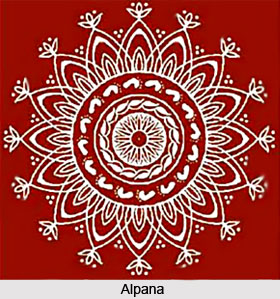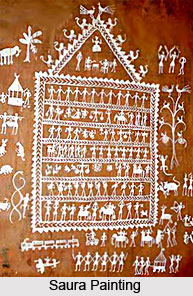 There has been a development of Indian tribal art since its inception. Fairs, festivals, local deities, Gods and Goddesses, legends, nature and animals play a vital role in the tribal painting in India. This traditional Indian tribal painting animates the immortal charm of Indian tribal life. Indian tribal art goes way beyond time in the history of India. Initially painting was done in black or earth colours, the palette soon expanded to include white, red, yellow, blue and green. From the onset of the 20th century, art slowly began to jump off the walls and on to palm leaves, wood blocks, cloth and ivory. Traditionally, the kinds of paintings found in India are: Alpana of Bengal, Kolam of South India, Rangoli of Maharashtra, Osa of Orissa, Aripana of Bihar, Sona Rakhna of Uttar Pradesh and Sathiya of Gujarat.
There has been a development of Indian tribal art since its inception. Fairs, festivals, local deities, Gods and Goddesses, legends, nature and animals play a vital role in the tribal painting in India. This traditional Indian tribal painting animates the immortal charm of Indian tribal life. Indian tribal art goes way beyond time in the history of India. Initially painting was done in black or earth colours, the palette soon expanded to include white, red, yellow, blue and green. From the onset of the 20th century, art slowly began to jump off the walls and on to palm leaves, wood blocks, cloth and ivory. Traditionally, the kinds of paintings found in India are: Alpana of Bengal, Kolam of South India, Rangoli of Maharashtra, Osa of Orissa, Aripana of Bihar, Sona Rakhna of Uttar Pradesh and Sathiya of Gujarat.
One can easily come across exquisite pieces of Indian tribal art in different parts of India. for instance, the eastern zone of India, like Orissa, West Bengal, Jharkhand and Bihar have a rich tradition of tribal art and the paintings they create have a deep rooted aesthetic value. The East part of India exhibits tribal arts like Orissa Tribal Paintings, Saura Painting, Santhal Painting, Khovar and Sohrai paintings which have a distinctive role to play in the tribal culture of India.
 Another Indian tribal art of eastern zone that has remarkable impact on the tribal culture of India is the Painting of the Santhal tribe and can be seen in Bihar, Orissa and West Bengal. The Khovar and Sohrai paintings occupy a significant part in the tribal art of India. Khovar is the mural art form practiced by tribal women artists during the marriage season from January to June. The Kurmi Sohrai in the hill forests of Hazaribag plateau could not be more different in their source of inspiration and stylistic expression.
Another Indian tribal art of eastern zone that has remarkable impact on the tribal culture of India is the Painting of the Santhal tribe and can be seen in Bihar, Orissa and West Bengal. The Khovar and Sohrai paintings occupy a significant part in the tribal art of India. Khovar is the mural art form practiced by tribal women artists during the marriage season from January to June. The Kurmi Sohrai in the hill forests of Hazaribag plateau could not be more different in their source of inspiration and stylistic expression.
The Indian tribal art had also developed in the western zone of India. The popular tribal art forms of India include Warli Painting of southern Gujarat and Pichhwai Painting of northern Maharashtra.
Indian tribal art form had also flourished in the Bastar district in Madhya Pradesh. The structures of Bastar range from simple unadorned tribal shrines to ornately decorated village temples. Moreover, the Malwa, Nimar and Tanwarghar regions of Madhya Pradesh are known for their Mandana wall and floor painting traditions.
These paintings are not just decorations, but also spontaneous overflowing of religious devotion, intrinsically associated with socio-cultural ambiance. Mud plaster base is utilised in this form of Indian tribal painting, over which linear patterns are incised with the fingers. Myths related to creation are also the subject matters for Gond or Bondi paintings. Painted freehand, these two-dimensional paintings replicate their perception of life.
These arts can be elevated by providing proper facilities, the government of India, as well as other societies and associations, have made all efforts to promote such art forms. These highly developed senses of composition, with gestures to highlight a sense of mood and works of beautifully stylised imageries, bring their legends to a level of realism.
















